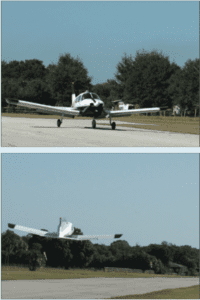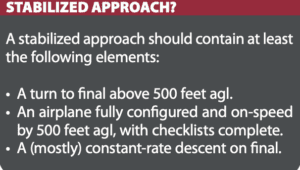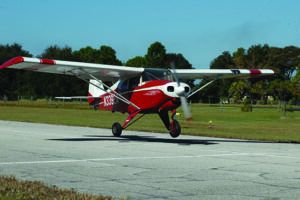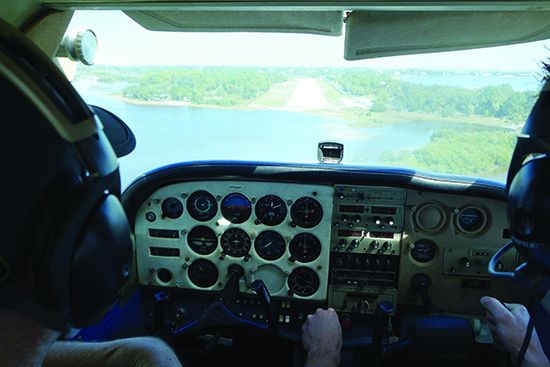Short-field landings have been part of my flying right from the onset of private pilot training. My instructor had flown in the Alaska Bush, and was very comfortable operating out of short airports, grass or otherwise. The go-to runways near me were Cranland Airport (28M), in Hanson, Mass., and Myricks Airport (1M8) in Berkley, Mass. They “featured” a 1700-foot paved runway and a 2500-foot grass strip with tall trees on each end, respectively. After the initial nerves and excitement faded, I was left with a sense of satisfaction. Tighter margins mean flying the airplane in a narrower envelope than usual. Speed control and energy management are always important, but become more critical in short-field operations.
When I got to the point in my career where a company actually wanted to pay me to fly the public, the first airplane I was assigned was the Pilatus PC-12. Talk about a short-field machine! There is nothing like being able to take eight passengers and luggage to airports like the Gustaf III Airport (TFFJ) on the Caribbean island of Saint Barthélemy or Elizabeth Field Airport (0B8) at Fishers Island, N.Y. The airplane may be bigger, but the general principles are still the same.
TAKEOFF
I know I have preached this before, so I apologize if I am being repetitive, but knowing your takeoff performance is critical in short-field operations. If I had to guess, pilots reading this are more diligent than the norm, but it amazes me how often I ask pilots about their takeoff and landing distance data and hear the answer, “It always works on days like this,” or, “I have never had a problem before.” Something to consider with larger airplanes is the range of liftoff or rotation speeds. Many manufacturers publish those speeds based on takeoff weight, and not adhering to them can adversely affect performance.
Short-field takeoffs largely fall within two categories: short fields where obstacle clearance is a concern and those where the takeoff path is clear. The latter is simpler, so let’s tackle that first.
Fisher’s Island (0B8), mentioned earlier, is a perfect example of a short field without concern of obstacles on departure. It is right on the coast, and the departure end of three out of the four runways leads right over the beach. The most important takeoff calculation is the ground roll.
THOUGHTFUL FLYING
You’ve probably heard this before when considering performance, but a critical factor is that AFM/POH numbers are calculated in near-perfect conditions with a new airplane and professional test pilots. If you consider wind, runway condition and density altitude, and calculate your takeoff ground roll to be 2499 feet, I personally would not consider it a safe decision to depart a 2500-foot strip. Remember that the airman certification standards (ACS) include personal minimums as an item on practical tests. Most pilots have a set of personal minimums when it comes to weather, like maximum winds, or minimum ceiling or visibility requirements, but do not really consider padding performance. In basic airplanes, a 1000-foot takeoff roll is common at sea level. You could add a 100-percent safety buffer to that number and still have room to spare at Fisher’s Island.
I often preach “thoughtful” flying, and this is an example of where it comes into play. It is a good operating practice to calculate takeoff data and see how that compares to your actual takeoff performance. This helps build confidence in the performance numbers, and can assist in determining a suitable buffer between calculated takeoff performance and runway length. I’ve known pilots who use anything from a 10- to 50-percent buffer in their performance. Additionally, it is not a bad idea to plan for calm winds or at least exclude the gust factor.

What makes a short runway short is in the eye of the beholder. When considering runway length, a major factor is the airplane, its requirements and performance. Next comes the pilot’s skill and experience. Finally comes conditions, including wind, elevation and temperature.
I presently base my Debonair from a sea-level, 2500-foot-long, 50-foot-wide paved runway, after years of basing at airports with at least 3500 feet. A normal (me, mostly full tanks and maybe one passenger) takeoff roll is around 1500 feet. Fill the tanks and seats and it’s closer to 2500. On a hot day, “heavy” takeoffs are a no-go—something has to give. It’s usually fuel, which requires planning ahead to both have some air in the tanks and stop somewhere nearby for gas.
Landings usually aren’t a problem: As long as I nail the appropriate airspeed on final, I easily can get down and stopped in about two-thirds of the runway.
Things get more interesting when they get windy. Stiff crosswinds flow around various obstructions adjacent to the runway, with an associated “sink hole” on final from one direction and dynamic conditions from the other. On one especially gusty day, I was lock to lock with the ailerons through 200 feet agl. That approach resulted in a go-around and diversion to a longer runway aligned with the wind until things calmed down.
The point is that margins for error are reduced on short, narrow runways, even if the available length is well within “book” performance and your personal minimums. Don’t let the book lull you into a false sense of security when conditions aren’t ideal. — J.B.
PROCEDURES
This should go without saying, but I will say it anyway: It’s critical to fly the airplane the way the manufacturer intends. For some airplanes, this means flaps set to a certain position. The performance numbers you worked so hard to calculate are predicated on it. Some manufacturers also recommend a static takeoff, meaning brakes are held until takeoff power is set, and then released.
For example, and according to the Airplane Flying Handbook, static takeoffs have not been shown to necessarily reduce runway requirements in all single-engine light airplanes, but there are other factors to consider. A static takeoff allows the pilot to ensure takeoff power is obtained and everything is ship-shape before initiating the roll. I use some variation of “takeoff power is set, gauges green, annunciators appropriate” as a callout prior to releasing the brakes. It is much easier to assess everything while stationary and focus on the takeoff while rolling, especially on a short field where accelerate-stop performance might be dicey.

Many accidents and incidents are associated with airspeed mismanagement, so it’s not a surprise angle-of-attack (AoA) indicators have gained popularity. Unlike stalling airspeed, which can vary substantially with bank angle or increased weight, a properly calibrated AoA indicator will always tell you when a stall is imminent, which can be extremely helpful at short fields. Accurately flying an appropriate speed based on current conditions allows us to wring out maximum performance before a stall occurs.
If the airplanes you fly do not have AoA indications, fret not: just go practice some old-fashioned slow flight, fully configured. Knowing exactly how the aircraft performs close to the stall while maintaining control is the goal. Practice a typical approach profile at altitude, descending 1000 feet or so at 1.3 VSO. Knowing the limits of the airplane and how it performs when close to those limits is the name of the game. Once that proficiency is gained, maintaining speed on approach should come naturally.
OBSTACLES
I mentioned two takeoff scenarios, and it’s time to conquer the second one: a short-field takeoff with obstacles. Take all the of the risk factors and mitigation strategies already discussed, and then add that “knowing is half the battle”: Understanding the size of the obstruction and distance from the runway is a great start. Briefing and flying the ODPs can help, especially at night or in marginal weather. Remember to calculate total takeoff distance, which considers the ground roll and a climb to 50 feet agl.
Once airborne, it’s also critical to immediately pitch to the manufacturer’s VX speed. Keep the focus on maintaining VX until the airplane is clear of obstacles before retracting gear or flaps. The airplane tends to go where the eyes go, and it is not ideal to be pitching down towards obstacles.
LANDINGS
As the saying goes, taking off is optional, but landing is mandatory. This is a nice blurb from the Airplane Flying Handbook: “To land within a short field or a confined area, the pilot needs to have precise, positive control of the rate of descent and airspeed, and fly an approach that clears any obstacles, results in little or no floating during the roundout, and permits the airplane to be stopped in the shortest possible distance.”
Easy peasy, right? Just fly a stable approach that clears obstacles, results in no float and allows for max-performance braking! Let’s talk about the approach itself first. I am not sure who coined the expression, but I have found it extremely true that “the first step to a good landing is a good approach.”
APPROACH

Something to consider when planning an approach to a short field is how much effective runway is available. If there aren’t obstacles, the whole surface is effective runway. If there are 100-foot-high obstacles on the approach end 30 feet from the runway, the first 1000 feet of the runway might not be usable. If there is any doubt or question of the height of the obstacles, do a flyover of the runway. You can focus on the approach profile while leaving the airplane fast, plan the approach and practice a go-around all at the same time. Once you have a plan, a stabilized approach should be the goal.
A wider pattern or longer downwind may be necessary to ensure the airplane is stable and on-profile by 500 feet agl. In a challenging approach with smaller margins, it is critical to eliminate as many variables as possible. Turning final late or trying to slow down below 500 feet agl will add to your workload and increase the chances of an undesirable outcome. Speed or energy management is the name of the game. If your airplane’s manufacturer does not publish a short-field approach speed, using no more than 1.3 VSO should do the trick, or 1.2 VSO when light, adding half the gust factor, as appropriate. It is important to coordinate pitch and power to maintain a consistent descent rate and speed. While excess speed can result in float, slow speeds can result in operations on the back side of the power curve. If this occurs, even the addition of full power might not be enough to overcome the drag of the high AoA. Reduce the AoA, and initiate a go-around.

A key aspect of short-field landings is the ability to precisely land the aircraft. Floating beyond the desired touchdown point can result in insufficient remaining runway to stop and coming up short could result in landing prior to the runway. Step one is proper energy management on approach, which I feel has been thoroughly discussed. After that, there is still the challenge of managing the rollout and flare. This varies from airplane to airplane and can be difficult to perfect because it happens so quickly. An early or overly aggressive flare can result in stalling over the runway (which honestly might improve short-field performance), something the passengers and airplane won’t appreciate. A late or shallow flare could result in a flat landing, bouncing or landing longer than expected. As always, pick a decision point for the landing. If the airplane is not down and in a position to apply braking prior to that point, initiate a go around and try again.
Luckily, we can work on these skills on every flight. We can even have some fun with it. When lined up on final, pick a point on the runway. Usually I use the touchdown zone markings, but if the runway does not have them, a centerline stripe is just fine. Land on that point. If the landing is long or short, assess the root cause and set a goal to improve next time. Aviation as a whole improves when we hold ourselves to higher standards.
TOUCHDOWN AND BRAKING
If your energy was properly managed, the rollout should occur on the desired touchdown spot with minimal float. There may be temptation to “drag it in,” where a more flat and low approach is attempted. This often leads to increased landing distance versus a steeper approach where some of the airplane’s energy is dissipated in the touchdown. Remember: It’s not a hard landing, but one with authority.
At touchdown, back pressure should be maintained for aerodynamic braking. Maximum braking should be applied, but this can be easier said than done. Many pilots have seen the end of a runway approaching too rapidly for comfort and locked up their brakes. It’s important to know where this occurs, because locked or blown tires do not bring the airplane to a stop as quickly as an effective technique. Plus, it will save everyone money on replacement tires and brakes.
SHORT AND TO THE POINT
Short fields require additional risk mitigation strategies, and it is critical to stay proficient. Tighter margins for error mean operating the airplane within a tighter envelope. While this needs to be treated with the respect it deserves, it should not deter you. Flying in that tighter envelope not only improves airmanship, but it is also extremely rewarding. Visit your local small airport to find out why it is sometimes better to keep it short!
Ryan Motte is a Massachusetts-based Part 135 pilot, flight instructor and check airman. He moonlights as Director of Safety when he isn’t flying.




